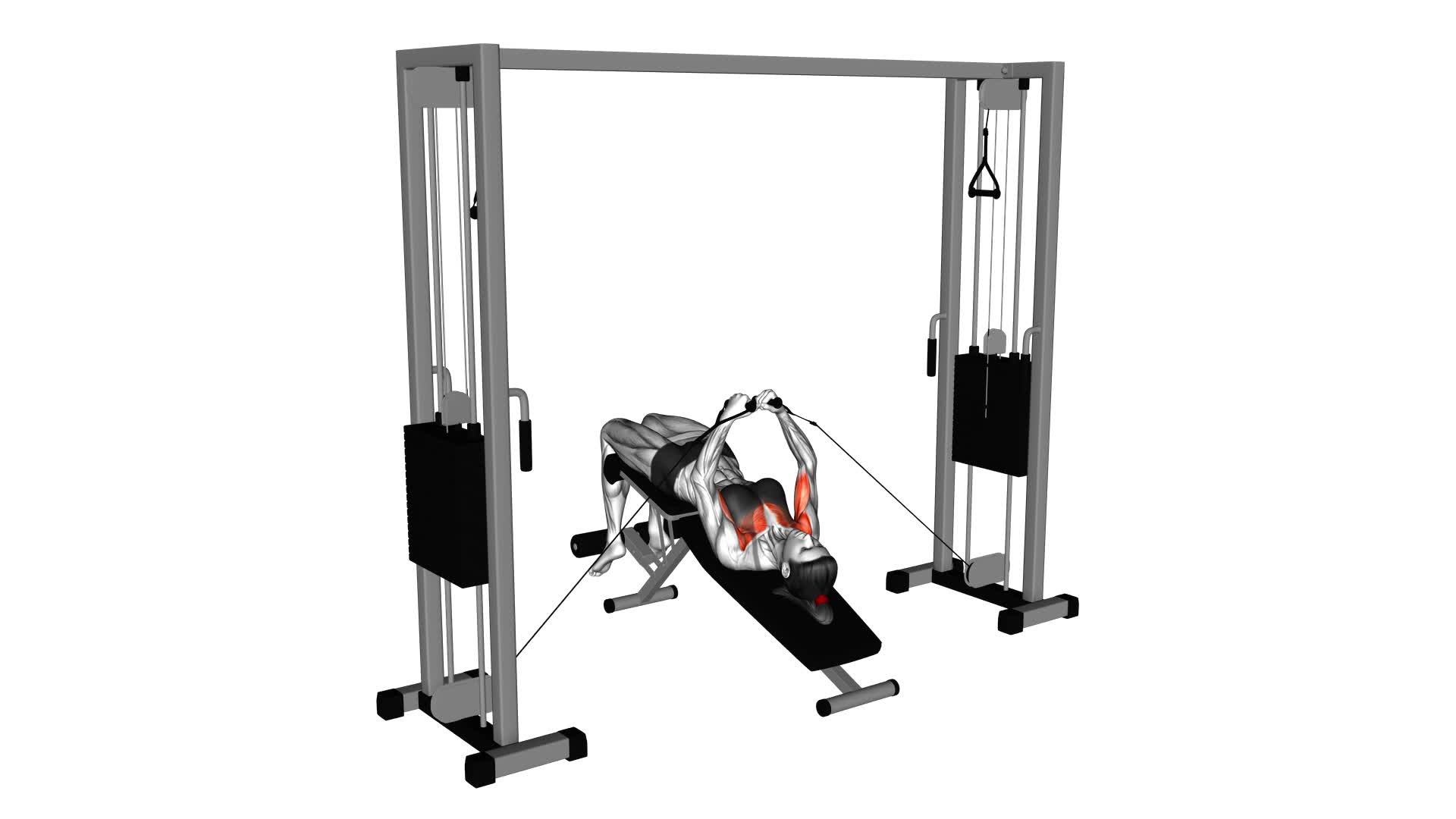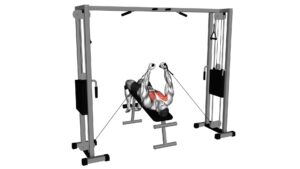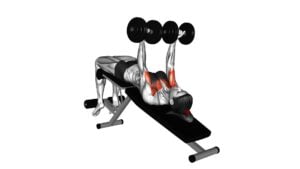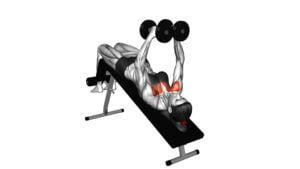Cable Decline Fly (female) – Video Exercise Guide & Tips

Looking to target your chest and build strength? The Cable Decline Fly is the perfect exercise for you!
Watch This Exercise Video
In this video exercise guide, we'll show you the proper form and provide tips to maximize your results.
You'll learn about the benefits, equipment needed, and variations of this effective workout.
Get ready to sculpt and tone your chest muscles with the Cable Decline Fly!
Key Takeaways
- Cable Decline Fly targets chest muscles, shoulders, and triceps.
- Cable Decline Fly provides a greater range of motion compared to dumbbell or barbell exercises.
- Cable Decline Fly isolates and strengthens chest muscles.
- Cable Decline Fly engages multiple muscle groups for a comprehensive upper body workout.
Benefits of Cable Decline Fly
You can experience several benefits from incorporating cable decline fly into your workout routine. This exercise targets your chest muscles, specifically the pectoralis major and minor, as well as your shoulders and triceps. By using the cable machine, you can achieve a greater range of motion compared to traditional dumbbell or barbell exercises, allowing for a more effective workout.
One of the key benefits of cable decline fly is its ability to isolate and strengthen your chest muscles. Unlike compound exercises, which work multiple muscle groups simultaneously, cable decline fly focuses solely on your chest. This targeted approach helps to improve muscle definition and increase overall chest strength.
In addition to targeting your chest muscles, cable decline fly also engages your shoulders and triceps. This means you're getting a more comprehensive upper body workout with just one exercise. By incorporating cable decline fly into your routine, you can save time while still effectively working multiple muscle groups.
Now that you understand the benefits of cable decline fly, let's talk about the equipment needed for this exercise.
Equipment Needed for Cable Decline Fly
To perform the cable decline fly exercise, you'll need a cable machine. This piece of equipment is essential for targeting your chest muscles effectively. The cable machine consists of a weight stack, cables, and handles that allow you to adjust the resistance and angle of the exercise.
There are various cable decline fly variations you can try to keep your workouts challenging and prevent plateauing. One variation is the single-arm cable decline fly, where you use one arm at a time to focus on each side of your chest separately. Another variation is the kneeling cable decline fly, where you perform the exercise while kneeling on the ground, providing a different angle of resistance.
If you don't have access to a cable machine, there are alternative exercises for cable decline fly that you can incorporate into your routine. These include dumbbell decline flies, which involve using dumbbells instead of cables, and machine decline chest presses, where you use a chest press machine to target the same muscle groups.
Now that you know the equipment needed for cable decline fly and the variations and alternatives available, let's move on to discussing the proper form for this exercise.
Proper Form for Cable Decline Fly
To execute the cable decline fly exercise with proper form, position yourself on the cable machine and grasp the handles firmly.
Here are some key points to keep in mind for proper form and technique:
- Body Positioning:
- Lie down on the decline bench and position yourself so that the cable handles are at chest level.
- Keep your feet planted firmly on the floor for stability.
- Engage your core muscles and maintain a neutral spine throughout the exercise.
- Movement Execution:
- Start with your arms extended straight out in front of you, maintaining a slight bend in your elbows.
- Inhale and slowly lower your arms out to the sides in a wide arc, maintaining control and a slight bend in your elbows.
- Exhale and bring your arms back to the starting position, squeezing your chest muscles.
- Avoid letting the weight stack touch or rest at the bottom of the movement to keep the tension on your muscles.
Common mistakes to avoid include using excessive weight, using momentum to swing the arms, and allowing the shoulders to shrug or round forward. Focus on muscle activation in the chest and maintain proper form throughout the exercise for optimal results.
Tips for Maximizing Cable Decline Fly Results
Maximize your cable decline fly results by incorporating progressive overload techniques. Progressive overload refers to gradually increasing the demands placed on your muscles in order to stimulate growth and strength gains. One way to do this is by gradually increasing the weight you use for the cable decline fly exercise. Start with a weight that challenges you but allows you to maintain proper form. As you become stronger, gradually increase the weight to continue challenging your muscles.
In addition to progressive overload, focusing on maximizing muscle activation is key for getting the most out of your cable decline fly. To do this, make sure to maintain a controlled and slow tempo throughout the exercise. This will ensure that you're fully engaging your chest muscles and not relying on momentum.
Avoid common mistakes in the cable decline fly, such as using too much weight and sacrificing form, or allowing your elbows to flare out to the sides. These mistakes can lead to ineffective muscle activation and potential injury. Instead, focus on using a weight that allows you to maintain proper form and keep your elbows slightly bent and pointed towards your feet.
Variations and Modifications for Cable Decline Fly
To further target your chest muscles and continue maximizing your cable decline fly results, let's explore variations and modifications for this exercise. By incorporating different modifications and variations, you can challenge your muscles in new ways and prevent your workout from becoming stagnant.
Here are some cable decline fly modifications and variations to consider:
- Hand Position: Instead of using a pronated grip (with your palms facing down), try a supinated grip (with your palms facing up). This slight change in hand position will shift the focus to different areas of your chest.
- *Incline Decline Fly*: Perform the cable decline fly on an inclined bench instead of a flat bench. This will target the upper chest muscles more intensely.
- *Single-Arm Cable Decline Fly*: Instead of using both arms simultaneously, perform the exercise with one arm at a time. This variation will engage your core muscles and improve stability.
- Resistance Bands: Incorporating resistance bands into your cable decline fly can provide additional tension and challenge. Attach the bands to the cable machine handles and perform the exercise as usual. The resistance bands will add an extra element of difficulty and engage your muscles in a different way.
Frequently Asked Questions
Can Cable Decline Fly Exercises Help in Reducing Breast Size?
Cable decline fly exercises can be a part of your fitness routine if you're looking to reduce breast size. These exercises target the chest muscles and can help strengthen and tone them.
However, it's important to note that spot reduction isn't possible, so these exercises alone may not lead to a significant reduction in breast size.
Additionally, it's always advisable to consult with a healthcare professional before starting any new exercise program to ensure there are no risks or side effects on breast tissue.
Can Cable Decline Fly Exercises Be Performed by Beginners?
Yes, cable decline fly exercises can be performed by beginners. It's a great way to work on your upper body strength. If you're new to this exercise, you can start with lighter weights and gradually increase as you get more comfortable. Additionally, there are modifications you can make to tailor the exercise to your fitness level.
Cable decline flys offer many benefits, such as targeting your chest muscles and improving overall upper body strength.
How Many Sets and Reps Should Be Performed for Cable Decline Fly Exercises?
To get the most out of cable decline fly exercises, advanced lifters like you should aim for 3-4 sets of 8-12 reps. This will help target your chest muscles effectively.
Incorporating cable decline fly variations into your chest workouts can bring many benefits. It helps strengthen your pecs, improves upper body stability, and enhances overall chest definition.
Can Cable Decline Fly Exercises Be Done With Resistance Bands Instead of a Cable Machine?
Yes, you can do cable decline fly exercises with resistance bands instead of a cable machine. While cable machines provide a more consistent resistance, resistance bands offer the advantage of portability and versatility. They allow you to target your chest muscles effectively, just like cable machines.
The benefits of cable decline fly exercises include strengthening your chest muscles, improving upper body stability, and enhancing overall muscle definition. So, give resistance bands a try for a challenging and effective workout.
Are There Any Alternative Exercises That Can Target the Same Muscle Groups as Cable Decline Fly?
If you're looking for alternative exercises to target the same muscle groups as cable decline fly, there are a few options you can try.
One option is the dumbbell decline fly, which works the chest muscles in a similar way.
Another option is the push-up, which also engages the chest muscles along with the shoulders and triceps.
Lastly, you can try the chest press machine or the chest dip, both of which can help you target those muscle groups effectively.
Conclusion
In conclusion, the cable decline fly exercise is a highly effective way to target and strengthen the chest muscles. By properly using the cable machine and maintaining proper form, you can maximize your results and achieve a stronger and more defined chest.
Additionally, incorporating variations and modifications into your workouts can add variety and challenge to your routine. Remember to always consult with a fitness professional before starting any new exercise program.

Author
Years ago, the spark of my life’s passion ignited in my mind the moment I stepped into the local gym for the first time. The inaugural bead of perspiration, the initial endeavor, the very first surge of endorphins, and a sense of pride that washed over me post-workout marked the beginning of my deep-seated interest in strength sports, fitness, and sports nutrition. This very curiosity blossomed rapidly into a profound fascination, propelling me to earn a Master’s degree in Physical Education from the Academy of Physical Education in Krakow, followed by a Sports Manager diploma from the Jagiellonian University. My journey of growth led me to gain more specialized qualifications, such as being a certified personal trainer with a focus on sports dietetics, a lifeguard, and an instructor for wellness and corrective gymnastics. Theoretical knowledge paired seamlessly with practical experience, reinforcing my belief that the transformation of individuals under my guidance was also a reflection of my personal growth. This belief holds true even today. Each day, I strive to push the boundaries and explore new realms. These realms gently elevate me to greater heights. The unique combination of passion for my field and the continuous quest for growth fuels my drive to break new ground.







